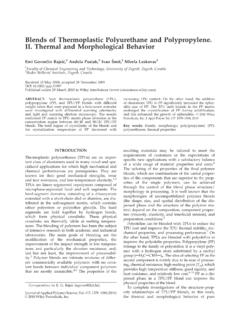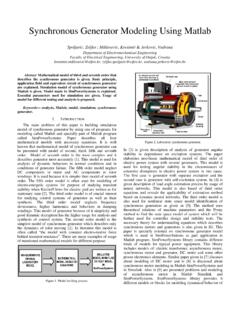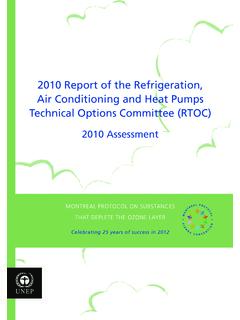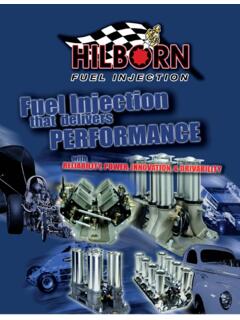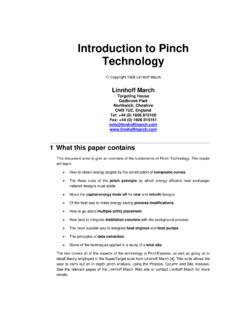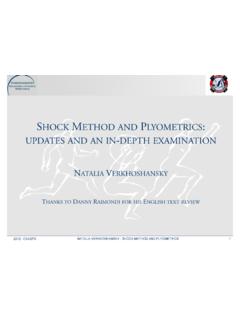Transcription of Calculation and Design of the Heat Pumps
1 1 1 Abstract Paper deals with Calculation and Design of the heat Pumps that are used for purposes of heating and cooling. Heat Pumps are systems that draw heat from one source (earth, water, air or ambient) and transfer it to another. Their operation is described by Carnot circular process, in which thermal energy is taken from one body to working medium and then from a working medium to the heated body. Energy put in the process is equal to the energy needed for moving and compression of the working medium. Authors have calculated that average energy input is equal to of useful thermal energy (output). Further on in the paper the working principle of the heat Pumps and their main parts are described.
2 Index Terms-- Compressors, Geothermal Energy, Geothermal power generation, Heating, Heat Pumps , Temperature Control, Thermodynamics, Thermomechanical Processes I. INTRODUCTION The time of cheap fossil fuels as the main drivers of civilization is nearing its end. The limited reserves of fossil fuel and they high price give the opportunity for introducing new technologies into commercial applications. Changes that took place on the planet's energy systems is not only affecting the type of energy sources, but also the centralized energy systems, in which the consumer is merely the last link. It is now possible to produce energy at the point where it is needed and thus avoid costly transmission.
3 This option not only changes the structure of the energy system but also the social structure of society, from collective to individual. Heat Pumps are systems that are characterized by the high output/input ratio. Average input energy is equal to of the output energy. This mean that for 1 W of electric energy heat pump transfer from the ground additional 3 W of geothermal energy which if we neglect loses is equal to the 4 W of thermal energy. Heat Pumps for primary source of energy uses thermal energy from air, soil or ground water. The most reliable source is the soil and groundwater due to their (approximately) constant temperature throughout the year [1].
4 Soil temperature at depths greater than 10 meters can be considered constant 1 This paper was financial supported by Faculty of Electrical Engineering Osijek and dean professor Radoslav Galic. Authors of this paper are grateful to professor R. Galic for support. and it depends on the geographical location is on average 6 degrees Celsius (Fig. 1). Fig. 1. Dependence of ground temperature on depth II. THE PRINCIPLE OF HEAT PUMP Ground energy is used in summer for cooling and in winter for heating purposes. Thermodynamic principle of the heat pump is described by Carnot circular process [2].
5 For heating purposes thermal energy of soil is collected in water - antifreeze solution that is then pump to the heat exchanger (evaporator), in which it transfer heat to working medium (like HFC-134a). Fig. 2. describes process by line between points 1 and point 2. When working medium gets to about 12 C it goes to compressor there his pressure and temperature rises from bar to 8 bar and 12 C to 60 C [6]. This is shown on Fig. 2. on line from point 2 to point 3. Now the working medium goes through second heat exchanger (condenser), where it transfer his heat to working fluid (water) that is used for heating the building.
6 Passing through the expansion valve (point 4 to point 1, Fig. 2.), the pressure of the working media fall to starting bar and process starts again. Working media is a sort of refrigeration gas. In past Freon Calculation and Design of the Heat Pumps J. Perko, Student Member, IEEE, V. Dugec, D. Topic, D. Sljivac, Member, IEEE, and 2 gas was used, but because its reactivity with ozone Freon (R-22) is no longer in used and is substituted with hydro fluorocarbons like HFC-134a. Fig. 2. Carnot cycle of HFC-134a Heat pump systems operate exclusively on the basis of temperature differences. For high temperature differences the transfer of the energy is faster.
7 In point 1 (Fig. 3.) working medium leaves the evaporator in which it took power from the ground; its temperature is around 12 C. This temperature is not sufficient to heat the room, so we have to compress the working medium in the compressor to raise his temperature to 55 C. In point 2 the working media leaves the compressor and now the fever goes to the condenser. In the condenser the working medium transfers its heat to working fluid (water) that is used to heat the building. Heated water can be used for floor heating (35 C), radiator heating (40 C 50 C) or with additional heating up in the boiler as hot water or steam.
8 After the working fluid delivered its heat on medium it exits from the condenser (point 3) and enters the liquid container. The purpose of this tank is to balance pressure and volume of media in the entire line of heat Pumps . After the liquid container, working fluid which is still under high pressure pass through thermal expansion valve where his pressure and the temperature is reduced to 1 bar and -6 C [6]. After that, the working medium is ready to re-take heat from the soil in the evaporator and thus continues to cycle. III. HEAT Pumps EXPLOITATION SYSTEM There are two basic systems of heat Pumps .
9 Closed circuit system uses a buried heat exchanger so that the working fluid is never in direct contact with the ground. Open system uses geothermal fluid as the working fluid (groundwater) from production well and after a process returns it to injection well [5]. Horizontal system with closed circuit (Fig. 4.) is used in places where there is sufficient space and suitable soil for construction works. The bundle of pipe is taken parallel to the soil to a depth greater than the depth of freezing (about 2 m). The disadvantage of this system is large fluctuations in soil temperature at such shallow depths. Fig. 3. The principle of heat pump 3 Fig.
10 4. Horizontal system with closed circuit Vertical system with closed circuit (Fig. 5.) is applied to objects that have a need for greater amounts of heat energy, in areas where the soil type is not suitable for horizontal system. Fig. 5. Vertical system with closed circuit For this system it is necessary to drill a deeper hole (100m to 200m) or more smaller (20m, 30m, 50m) ones. Polyethylene-based pipes were placed in a U-shaped with a strong coupling at the bottom. Vertical system with open circuit (Fig. 6.) is effective in the case of abundant groundwater. Fig. 6. Vertical system with open circuit Underground water is directly pumped from a production well, and after passing through the heat pump system returns in the injection well that is at least 15m away.


